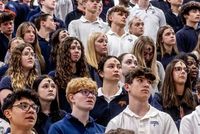On September 8, 2025, President Donald Trump took to the stage at the Museum of the Bible in Washington, D.C., announcing a new initiative that has reignited the national debate over the role of religion in public schools. Speaking before his Religious Liberty Commission, Trump declared that the Department of Education would soon issue new federal guidance designed to "protect the right to prayer in our public schools and [provide for] its total protection," according to multiple reports, including TNND and Washington, D.C. Newsroom.
Trump’s remarks, delivered with characteristic bravado, left little doubt about his intentions. "To have a great nation, you have to have religion. I believe that so strongly," he said, emphasizing his administration’s commitment to "bring back religion in America" and to "protect the Judeo-Christian values of our founding." The president insisted that, under his leadership, the United States would remain "one nation under God, and we always will be."
The new guidance, while yet to be detailed, is part of a broader push by the Trump administration to reassert religious expression in public spaces, particularly in schools. Trump claimed that students are currently "indoctrinated with anti-religious propaganda," and some are even "punished for their religious beliefs." He cited several cases, including that of Hannah Allen, a Texas student who was censored by her school for leading a prayer for an injured peer. After legal intervention, her school changed its policy to allow prayer in public view, provided it did not disrupt school activities. "Hannah very strongly stood her ground and she won," Trump recounted, adding, "Hannah, I just want to thank you for letting the light of your faith shine for all of those to see. We really appreciate it."
Other stories shared at the commission meeting included students being told to remove a face mask with "Jesus loves me" written on it, restrictions on referencing God in valedictorian speeches, and initial prohibitions against singing Christian songs at school events. In each instance, the schools eventually relented, permitting the students to express their faith publicly.
Trump’s announcement was met with cheers from many in attendance, but it drew sharp criticism from secular organizations and advocates for the separation of church and state. The Freedom From Religion Foundation (FFRF), the nation’s largest freethought association, condemned the event, with co-president Annie Laurie Gaylor stating, "From the Christian prayers to the Christian nationalist lineup of speakers, this commission is not protecting religious liberty — it’s promoting Trump’s political agenda and a false narrative that America is a Christian nation." Americans United for Separation of Church and State echoed these concerns, accusing Trump of "using religion to promote his self-aggrandizement and political agenda, all the while perpetuating the lie that America is a Christian nation and that religion is under attack."
The new guidance, critics argue, may not be as groundbreaking as Trump claims. As Slate pointed out, existing Department of Education guidelines already permit students to pray during noninstructional time, read sacred texts, and pray with others outside of class. The Supreme Court’s decision in Kennedy v. Bremerton even allows public school coaches to lead overtly Christian prayers on the field, provided participation is voluntary. "What more does Trump want?" the publication asked, suggesting that the president’s real aim may be to enable schools to require Christian prayer and display religious texts like the Ten Commandments in classrooms.
This suspicion is not without precedent. Conservative states such as Texas, Arkansas, and Louisiana have introduced laws mandating school prayer or the display of the Ten Commandments, though these measures have generally been struck down by lower courts. Observers believe the ultimate goal is to bring such cases before the Supreme Court in hopes of establishing a new legal precedent. Texas Attorney General Ken Paxton, for example, has advocated for requiring students to recite the Lord’s Prayer, while expressing "concerns" about Muslim students praying privately in classrooms.
Trump’s Religious Liberty Commission itself has come under scrutiny for its composition and focus. Despite claims of representing "all faiths," the commission and its advisory boards are overwhelmingly populated by conservative Christian and Jewish appointees, with only a handful of Muslim lay leaders and little to no representation from other religious traditions. According to Slate, Trump’s tally of "victories for people of faith"—now reportedly at 100—are virtually all on behalf of Judeo-Christian causes, with several unrelated to religion and some involving policies against transgender individuals.
Beyond the school prayer initiative, Trump used his speech to address a range of topics, from combating "wokeness" at the Smithsonian Institution to cracking down on crime in Chicago. He claimed, without evidence, to have reduced crime in Washington, D.C. to "virtually nothing," and made controversial remarks about domestic violence, suggesting that "things that take place in the home, they call crime." These comments, particularly his characterization of domestic violence as mere "little fights," drew criticism from advocates and commentators alike.
Central to Trump’s new campaign is the "America Prays" initiative, a call for Americans to unite in prayer for the nation’s strength, peace, and prosperity ahead of the country’s 250th anniversary. The initiative encourages the formation of prayer clubs to meet for one hour each week, organizing prayers by topics such as government leaders, cultural renewal, and families. The accompanying website provides suggested prayers, historic sermons, and biblical passages, positioning the movement as a return to the religious roots of the nation’s early settlers.
However, not everyone is convinced by the administration’s framing. Critics argue that the initiative is part of a broader "Christian Nationalist agenda," designed to blur the line between church and state and to promote one set of religious values over others. They point to the administration’s prior social media posts, such as the Department of Homeland Security’s sharing of the 1872 painting "American Progress"—a symbol of Manifest Destiny and Christian expansionism—as evidence of a coordinated effort to recast American identity in religious terms.
As this debate unfolds, the country finds itself once again grappling with the complex intersection of faith, politics, and public education. Supporters of Trump’s initiative see it as a long-overdue correction to what they view as decades of secular overreach, while opponents warn of the dangers of government-sponsored religion and the erosion of constitutional protections for minority faiths and nonbelievers. With the Department of Education’s new guidance expected soon, the battle over prayer in public schools—and over the very meaning of religious liberty in America—shows no signs of quieting down.
For now, the only certainty is that the nation’s classrooms, and the broader public square, remain at the center of a struggle over values, rights, and the future of American identity.

